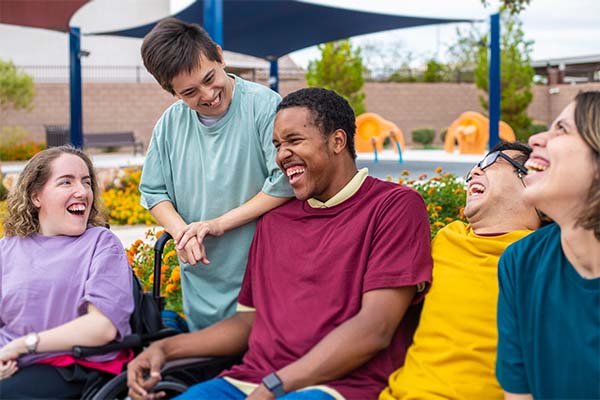Every differently abled person is special, but not the same.
Our society has a tendency to put differently abled individuals into a box. But just like you have unique experiences and lifestyles, these individuals are human beings with special talents and challenges. If we are going to help differently abled people live to their fullest potential, we need to understand their circumstances.

Let’s dive deeper into their current socio economic state and learn about their different conditions.
Facts & Figures
Overview
- 1 in 6 children in the U.S. has a developmental disability (CDC and Health Resources and Services Administration).
- 50,000 individuals with autism turn 18 and become adults, aging out of public programs and services every year in the U.S. (2017 National Autism Indicators Report).
- 25,000+ adults with developmental disabilities await services through state-sponsored programs in Florida alone (MedicaidWaiver.org).
- 5+ million people in the USA are living with Autism (CDC, April 2020).
Education
- 34-37% of youth with autism/intellectual disabilities are less likely to have access to post-secondary education opportunities and employment.
- Over the next 10 years, universities nationwide are projected to face a significant increase in the number of students with intellectual disabilities.
Employment
- About 8 in 10 of persons with disability were not in the labor force in 2020, compared with about 3 in 10 of those with no disability (Bureau of Labor Statistics, U.S. Department of Labor, 2021).
- Persons with a disability were less likely to work in management, professional, and related occupations than those without disability—36.1% compared with 43.3% (Bureau of Labor Statistics, U.S. Department of Labor, 2021).
- Young adults with disabilities who receive a postsecondary degree or certificate are more likely to be employed (83%), compared to those with lower levels of education (38%-58%) (U.S. Department of Education, 2011).
- Average hourly wages are higher for adults with disabilities who had completed a postsecondary program compared to adults who complete only high school (U.S. Department of Education, 2011).
Health Care
- Adults with intellectual disabilities experience poorer health outcomes and more likely to:
- Live with complex health conditions.
- Have limited access to quality health care and health promotion programs.
- Miss cancer screenings.
- Have poorly managed chronic conditions, such as epilepsy.
- Over half the number of children with Autism live in a low-income household and tend to have lower health outcomes and higher parental-reported Autism severity (2020 National Autism Indicators Report).
Signs and symptoms
The FIU Embrace Center for Advancing Inclusive Communities most commonly serves—but is not limited to—the populations that live with the following neurodevelopmental conditions:
Intellectual disabilities (ID) - This term is used when there are limits to a person’s ability to learn at an expected level and function in daily life (CDC).
Signs and symptoms may include:
- Development delay in sitting up, crawling, or walking compared to other children
- Difficulty speaking or remembering things
- Difficulty understanding social cues
- Difficulties with problem-solving
Autism Spectrum Disorder (ASD) - Autism spectrum disorder (ASD) is a developmental disability that can cause significant social, communication, and behavioral challenges (CDC).
Signs and symptoms may include:
- Avoiding eye contact
- Not responding to their name or showing facial expressions by 9 months old
- Experiencing delays in developmental milestones
- Getting upset by changes in routine
- Impulsive or obsessive behavior
Down Syndrome - Down syndrome is a condition in which a person has an extra chromosome (CDC).
Signs and symptom may include:
- Short stature, compared to other adults and children
- A flattened face
- Almond-shaped eyes that slant upward
- A tongue that has the tendency to stick out
- Small ears and a short neck
Causes
Causes vary depending on the diagnosis. Oftentimes, it is simply caused by differences in the brain, such as a genetic condition or an extra chromosome as is the case in people with Down Syndrome. However, researchers have yet to discover why these developmental conditions occur.
Treatments
Although there is no “cure” for these lifelong conditions, there are interventions available to help individuals navigate everyday life including
- Behavior and communication interventions
- Occupational, physical, and sensory integration therapy
- Dietary treatments and supplements
- Medication to help individuals manage symptoms
Every differently abled person reacts differently to treatments, so it is important to consult a healthcare professional.